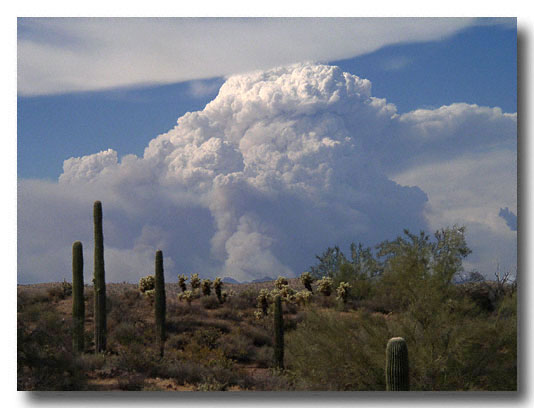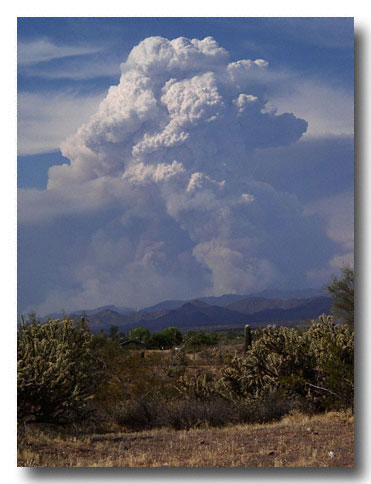Up in Smoke
August 8, /2004
I just got back from a whirlwind trip to the Ohio / West Virginia border area. I headed out on Thursday afternoon and was back by Saturday afternoon after driving just over 700 miles. I don't often get time to just sit and ponder, but as I thought about three job opportunities that seemed to present themselves on my doorstep I remembered some images that I took in Arizona on the last weekend of June.
Just before my trip I went ahead and scheduled a phone interview for a time when I knew I would be on the road. I figured that the drive would be easy and I could concentrate easily while on the road. As the conversation progressed I had some conflicting thoughts, the first being that I'd love an option to pack up and move to the southwest, and the second wondering why in the world, if I was going to start a "scratch business operation," would I do it for a bank and not for myself.
This one started to dry up before it started.
But speaking of the southwest, it's pretty well known that wildfires are a common summer occurrence. Few people realize however, that fires can sometimes create their own weather, and that it can end up both fanning the flames of the wildfire and affect lives hundreds of miles away.
What happens is that the fire actually becomes a kind of perpetual motion machine, an engine of death and destruction that feeds on itself. As the fire burns, the warm air rises, taking with it smoke particles. Water molecules that are formed as a byproduct of combustion attach to the smoke particles and condense. The air continues to rise, beginning an updraft that causes the fire to burn faster and faster.
As the cycle continues, the updrafts intensify and suck in air from all quadrants. Imagine trying to fight such a beast, when it grows in strength and intensity, minute by minute.
On June the 28th my daughter and son-in-law and I were heading out for a late afternoon lunch at Saguarro Lake, on the east side of Phoenix. For quite a while I had been watching a thunderhead building to the north in the clear blue sky of the hot afternoon. The temperature hovered around 107 and waves of heat were starting to reflect off of the asphalt.
Suddenly I made a quick U-turn in the street and headed back in the opposite direction.
"What's up?" the kids both asked.
"I saw a good place to pull over about a block back," I said and then proceeded down the road. Soon I made a quick right turn into the parking lot of an abandoned building. Looking around I headed right over the back curb of the parking lot and into the field behind the store. No one was worried about the off-road trek, for I had somehow landed a brand new Durango for my rental car.
"What are you doing?"
"See that storm cloud to the north? There is something strange going on. In fact, I think I see smoke at the bottom of the cloud. I've got to get a picture, even if I don't have my good camera with me."
This was one of those times when although I wished I had the better lenses with me, my smaller Olympus would be adequate, especially since I was able to boost the range with a telephoto converter.
At 2:20 PM I steadied the camera on a fence post and took several images. I wanted to stop at this particular place since the mountain in the foreground was begetting to obscure the view of the base of the cloud.
When the air is really clear, looks can be deceiving, and I suspected that this storm was maybe only 20 or 30 miles away. As we continued to head east and down to the lake, the cloud disappeared from view and I forgot about it during lunch.
I had thought about renting a boat for the afternoon but since there were no deals to be had, we headed for the parking lot and drove todward home.
After just a mile or so of driving, we came over the crest of a hill and wham, there it was again, this time without a mountain obscuring the view. I quickly looked for a side road and pulled over as soon as I could. The time was 3:52 and the stormcloud had been building for almost two more hours.
Twenty minutes later we were again about to lose our view of the storm so I pulled off for one last shot. I asked the kids if there was a road that would head on north, but my son-in-law suggested that it would take hours and hours to get up to where the storm was.
If I was alone I would have probably headed north, only to find that the route I would have taken would have not given me the access to the flames that I was looking for. It turned out that this storm was fueled by what became known as the Willow Creek Fire, just outside of Payson, Arizona. The first image was taken almost 60 miles south of the base of the fire, and had we turned north out of the canyon road we could have been there in just over an hour.
(4:08 PM -taken just outside of Fountain Hills, AZ)
As we had already had a long day looking at condos and wandering about the countryside, I reluctantly headed back to the kids house.
So you might ask, what's all this got to do with opportunities and a long drive to the edge of Appalachia?
After we returned home that evening in Arizona I was convinced that if I could find another vantage point, I could get a great shot of the cloud radiated by the setting sun. I took my camera with me and ran off to the store for a couple of items that were missing for dinner. Just as I came out and began to think about where to drive for another shot, a band of high cloud blocked the sun, and my great plan for a great shot, like so many other things lately, went up in a big cloud of smoke.
But it's also gotten me to thinking, that some of those opportunities were just plain wrong, and perhaps what I need to do is concentrate on building my own fire, one that I can keep under my control.




